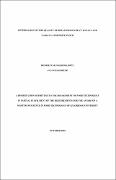| dc.description.abstract | Bananas and cassava are important staple foods in terms of caloric intake in Uganda. These
traditional crops are highly perishable with little value addition. This study examined the prospects
of application of banana, cassava and wheat composite flour in the development of bread. Sixteen
composite flour blends were prepared using D-optimal constrained mixture design within a range
of 40 to 80% for wheat, 10 to 30% for cassava and 10 to 30% for banana. Nutrient quality and
sensory acceptability of the breads were optimized using design expert software. Baseline
assessment on bread consumption was conducted from Kampala city. Information on bread
consumption and purchasing behaviour was collected using a questionnaire. Banana (EAHB)
cultivar cassava (NASE 19) and wheat were used for bread development. Moisture was analyzed
using hot air oven (BTI-29, India), dry ashing for ash using a muffle furnace (FSL 340-0 I 00,
Gallenkamp, UK), Kjeldahl method for crude protein, Soxhlet method for crude fat and
Gravimetric method for crude fiber. Total carbohydrate content of bread was determined by
difference method. Loaf weight and loaf volume were evaluated using a digital laboratory scale
(CE-4101, China) and rapeseed displacement method, respectively. Bread firmness was
determined using a TA XTplus texture analyzer (Stable Micro Systems, Gudaiming, Surrey, UK).
Sensory attributes (taste. odor, color, texture and overall acceptability) were evaluated on a five-point
hedonic scale.
Bread consumption was high (66.4%) amongst young people. A large (37. l %) proportion of the
population consumed bread daily and sweet bread was mostly (88.2%) liked. Over 70% of
respondents preferred white bread to whole meal bread. Large companies (56. l %) were the main
purchasing points because bread was considered to be fresh. Freshness (36.4%) was the most
important criteria for preference of bread. Blending had a significant effect on carbohydrate,
protein, ash, loaf volume, taste and odor (p<0.05). Banana addition increased mineral amounts in
bread whereas cassava increased total carbohydrate. The optimum blending ratio for both
nutritional and sensory acceptability was in the range of 71.2% wheat, 10.6% cassava and 18.2%
banana flours. Loaf volume ranged between 803.3 and 13 l0cm3. Loaf volume of bread processed
from less than 70% wheat flour was inferior. Crumb firmness values ranged from 6.4 to 29.8 N.
Bread developed from 50% wheat, 40% banana and 10% cassava had the highest (29.8 N) firmness
whereas that made from 80% wheat, 10% banana and l 0% cassava had the lowest (6.4 ) firmness.
It was concluded that controlled processing of banana and cassava flours, maintaining wheat flour
around 70% and high proportion of banana flour (about 17%) in the blend, would lead to
production of high quality bread with high content of minerals and bioactive compounds such as
polyphenols, flavonoids etc. Bread from banana, cassava and wheat was of good quality to
consumers. | en_US |

